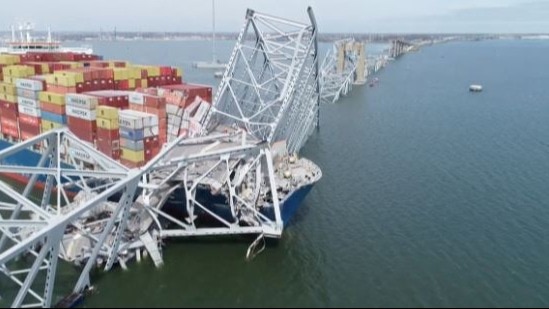2024-03-28 13:00:23
At about 1.30 am on Tuesday, the Francis Scott Key Bridge, across the Patapsco River in Baltimore, Maryland, collapsed after a 985-foot-long cargo vessel called the Dali reportedly lost power and hit the bridge’s pylon or pier. India Today obtained satellite images of the bridge before and after the incident from Planet Labs. These illustrate the extensive damage caused to the bridge.
EXPERTS WEIGH IN
“The bridge is 2.6km long, built in 1977. The supporting structure — the bridge piers — is made of reinforced concrete. The metallic truss of the superstructure was continuous,” said Dr Sotirios Argyroudis, Associate Professor of Infrastructure Engineering at Brunel University in London. “The collapse occurred when a ship collided with one of the bridge piers, leading to the failure of the metallic truss. This exemplifies a common mode of failure known as progressive collapse.”
In such cases, Argyroudis explained, the removal of one boundary of the bridge support — in this case, the pier — causes a redistribution of loads that the metallic truss cannot effectively bear, resulting in its progressive collapse.
As per open-source information, the collapsed section of the bridge measures 805m. It was a typical continuous truss bridge with about a 1,200-foot distance between the two critical pillars, supported by hundreds of struts that hold the pressure evenly. A critical pillar’s collapse increased pressure on the struts, which caused the bridge to rise before collapsing.
This is what’s called a progressive collapse — the failure of one structural element leads to the failure of neighbouring elements, which can’t support the new loads placed on them.
“The collapse of the bridge’s 804-metre-long three-span section appears to have been caused by the massive container cargo vessel DALI impacting and demolishing one of the two main bridge piers. This took away vital support from the steel truss superstructure with its suspended roadway, such that the whole three-span section suffered from catastrophic structural failure and collapsed into the river below,” said California-based marine engineer Alan Hayward.
Experts also said that forensic investigations may take 1-2 years as lab testing and collapse scenarios will have to be analysed to come up with plausible/reasonable simulations of what might have happened.
AGEING INFRASTRUCTURE
Analysing videos and footage of the crash, experts were quick to point out that the dolphins (small round objects around piers) were inadequate in deflecting anything other than small vessels.
Referring to the era when the bridge was built, structural engineer Ian Firth said: “Dolphins have been commonplace since the Sunshine Skyway collapse in 1980. However, this bridge was built in the 1970s, so the design would not have incorporated these devices at that time. The fact that a vessel can veer off course and hit the pier is the reason to design vessel impact protection systems so that a large vessel cannot hit the critical bridge support”.
“When the steel truss road bridge was designed and built in the 1970s, there likely wasn’t a requirement to consider disproportionate collapse and structural integrity. It’s conceivable that the piers weren’t designed to withstand the magnitude of today’s ship impacts, as vessels like the Dali weren’t navigating the Port of Baltimore during that era,” said Toby Mottram, professor of structural engineering at the University of Warwick.
Engineering consultant Robert Beinam added, “I do not know what the arrangements were for this bridge, but major bridges over shipping lanes must have substantial protection for piers or columns. These protections are either in the form of structural protection like sacrificial dolphins. They can also be in the form of artificial islands; these are for very large ships and mean the ship will never reach the bridge pier itself. Clearly, the protection of the piers in this instance was inadequate”.
WHAT WENT WRONG?
Approximately 42 per cent of bridges in the US, Argyroudis said, are over 50 years old, potentially posing safety risks in certain instances. Ageing infrastructure is particularly vulnerable to deterioration caused by corrosion and other environmental conditions. Exposure to various hazards such as earthquakes, floods, hurricanes, and human-induced stressors like collisions and explosions exacerbate their risk of failure. Compounding the issue, current traffic loads often exceed what these bridges were originally designed for. “Conducting resilience assessments of our infrastructure is crucial for informing future investments in infrastructure improvement,” he said.
“Normally, in the case of old bridges, if bridge engineers perform structural assessment they will investigate a scenario of ship impact and what damage it might cause. At this point, the robustness of the bridge is key to avoid progressive collapse as we saw in the videos,” said Dr Mehdi Kashani, Associate Professor in Structural and Earthquake Engineering at the University of Southampton.
Francis Scott Key Bridge collapse, US bridge collapse, experts on US bridge collapse, Maryland bridge collapse, bridge collapse in Maryland, Baltimore bridge collapse
Source link
11 total views , 1 views today
